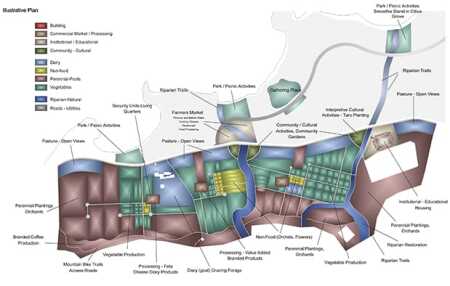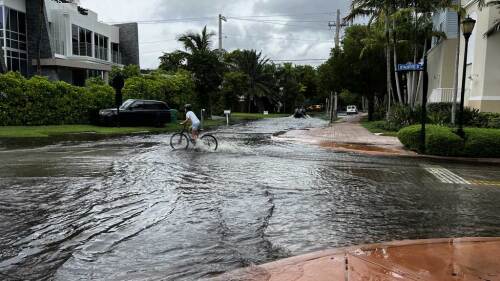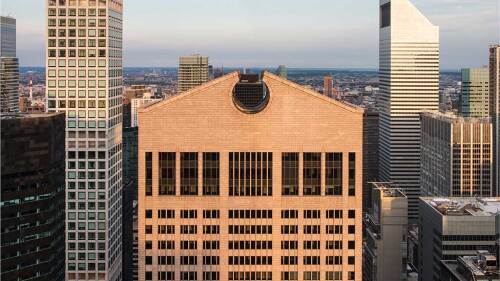The idea of building residential developments in the United States around golf courses is being rethought as demand for golf facilities continues to fade. The National Golf Foundation (NGF) reports that 2013 was the eighth-consecutive year that golf course closures outpaced openings, with 158 closures and 14 openings. Ninety-six percent of those closures were public courses. The foundation also reports that there had been an estimated drop of 600,000 golfers compared with the year before, reflecting a continuing decline in golfing since 2006. The total decline in golfers since 2006 has been roughly 4 million. Following a 40 percent growth in golf in the United States from 1986 through 2005, a period when more than 4,500 courses opened, 643 18-hole courses have closed since 2006, according to the NGF.
Related: Top Golf Rethinks Conventional Driving Ranges, Entertainment | Growing Sociability
“Millennials do not appear to be [taking up] the game. It takes too much time and expense to play and to buy the equipment. I think we’ve reached a period where the number of people playing golf is going to continue to decline,” says Matt Powell, an analyst for SportsOneSource, a market research firm. “Older people are going to continue to play, but there will be fewer of them. With the recession, a lot of people saw their retirements, their nest eggs, diminish, so they will have to work longer. If they’re working longer, they don’t have the time to play golf, and if they’re trying to accumulate money for retirement, they probably won’t have the money to play golf.”
All of this has taken a divot out of residential developments being built around golf courses. “When developers figured out that golf courses helped them sell houses at premium prices, the rush to develop golf course communities was on,” says Ed McMahon, ULI senior fellow. “They could get 10 to 25 percent more than an exact house not next to a golf course.”
“For the first time, developers are looking for amenity options other than building golf courses. Developers drove the industry to the heights it achieved building 400-plus golf courses a year. Now, we’re closing more than we’re opening,” says Bobby Weed, a golf course architect and owner of Ponte Vedra Beach, Florida–based Bobby Weed Golf Design.
“It’s not that golf is not still valued; golf courses are overbuilt,” says Heidi Majerik, director of development for Forest City Stapleton in Denver. In fact, in 2005, at the peak of golf facility supply in the United States, there were about 16,000 total courses, including all public courses, private courses, residential developments, and resorts, according to the NGF. As of January 2014, the total U.S. supply of 18-hole golf courses was 14,565, according to the NGF. The foundation expects this market correction to continue for the next few years, predicting an annual net reduction of supply to be in the 130-to-160 range, according to an online NGF report. A large portion of these are expected to be public facilities.
Market saturation made John Reed, president and chief executive officer of Reed Development Group, which developed six golf courses in four residential communities in South Carolina’s Lowcountry in the 1990s and early 2000s, do what may be one of the biggest golfing mulligans (do-overs) ever. In 2005, while developing a fifth golf and country club community, which featured a Pete Dye course and a Tom Fazio course, Reed and his partners realized that the baby-boomer market wanted something very different.
“When you think golf and country club, you think formality and exclusivity. That’s not what the majority wants today,” says Reed. “A sense of belonging and being part of a community is very important to a large majority of the boomer market. We need to feel that we are an integral part of our community or neighborhood,” says Reed. “Therefore, we decided on the anti-golf-and-country-club-type community and atmosphere. We dug a 170-acre [69 ha] lake instead of building a golf course.” Both courses had been designed and permitted, but not yet built. “We met with hundreds of women and asked what they wanted, and Hampton Lake is the result. It won a BALA [Best in American Living] award in 2009 from the National Association of Home Builders for Best Community in America. It is inclusive, casual, multigenerational, sustainable, and all about fun, family, and friends,” Reed says. Lakefront lots sell for 2.5 times the price of a wooded or preserve lot. And although there is no golf course in this development, residents may play golf at neighboring Reed Development golf courses.
Golf Rescue
Toll Brothers has taken another approach—sticking with a golf strategy, but updating it to appeal to the whole family. “When the world stopped in 2008, there were golf communities that were half built or partially built,” says David Richey, president of Toll Brothers’ Golf and Country Club Division, noting that Toll Brothers has been absorbing existing incomplete communities in North Carolina, Maryland, and Florida. For example, Hasentree in Raleigh, North Carolina, is a golf development that Toll Brothers purchased out of bankruptcy. In that case, 40 homes out of the 571 planned homes had been built. Toll Brothers purchased the development and is selling and building the remaining 531 homes. The Hasentree Clubhouse will open in January 2015.
Oak Creek in Upper Marlboro, Maryland, is a golf community that opened in 2010, but the golf course was closed 11 months later. Toll Brothers, in conjunction with homebuilder NVR, which purchased the development in 2012, have brought the golf course—which had been overgrown—back to life. The clubhouse is under construction and will open in May 2015.
“We’ve become entertainers,” says Richey. “Today golf events are important, but you’ve got to have events for all the other people in the family.” Food and beverage, fitness, and wellness programs are all part of the mix, he says. “There is no lack of people who want to live on a golf course fairway where you have a million-dollar view and you don’t have to maintain it,” he says.
Toll Brothers is, however, making some changes, allowing areas that golfers do not touch to return to a non-irrigated, unfertilized state and planting flowers only along the first and last holes where they will make the biggest impact instead of along all 18 holes. “In a lot of these locations, we were just putting food out there for the deer anyway,” Richey says. He added, “The practice facilities, in many cases, are becoming a family affair, with specific nights set aside for the entire family to come out and receive tips from the pros, along with piped-in music and beverages.”
Repurposed Courses
Bobby Weed Golf Design repurposes clubs, compressing a development’s golf envelope and carving out acreage for a development enclave. “It’s easier to permit a partial conversion and take 27 holes to 18 holes or down to nine, or reduce an 18-hole course to nine holes and then turn that nine acres into a development parcel,” Weed says. “There is often tremendous political and emotional resistance to removing a golf course completely. A partial conversion circumvents that resistance because it results in the improvement of the residual golf component,” says Chris Monti, senior associate of Bobby Weed Golf Design. “A portion of the value created by the development parcel is used to renovate and update the course, providing a benefit to every stakeholder in the process.”
Many of golf’s stakeholders are advocating nine-hole golf, or “executive golf,” as it is called, for time-pressed players. Almost half of core golfers—age 6 and over, eight or more rounds a year—said that a round of four hours and 20 minutes is too long, according to a recent NGF survey. There are 4,175 stand-alone nine-hole golf facilities in the United States, or 27 percent of total supply, according to a 2014 study conducted by the NGF for the U.S. Golf Association (USGA). With the USGA’s launch of its “Play 9” campaign in July, more nine-hole courses may emerge in the future. “There is a trend: some people see a nine-hole course as having as much value as an 18-hole course,” says Richey of Toll Brothers. “A lot of people don’t have four hours to play 18 holes. The nine-hole course satisfies the needs and wants for green space and provides the same value of a view outside your window as if it were 18 holes,” he says.
Alternative uses for courses during the off-season are being planned in some cases. “In the winter, some Colorado, Minnesota, and other Snow Belt golf courses will be groomed for cross-country skiing,” says Kimberly Erusha, managing director, Green Section, for the USGA.
Quint Redmond, chief executive of AgriNETx, a sustainable agricultural development company based in Golden, Colorado, that works with developers on ways to create more-sustainable communities, is approaching the challenge creatively. “We don’t necessarily convert a golf course completely. We take part of it to grow things in the rough,” Redmond notes.
For example, Redmond will have goats grazing in the rough on the golf course at the Turtle Bay Resort, where AgriNETx designed the agricultural master plan for a 469-acre (190 ha) parcel on the north shore of the island of Oahu in Hawaii.
Temporary electric fencing will keep the goats off the fairway; as they forage, they will help with maintenance, and their milk will be used to make feta cheese, which will be sold to local restaurants and residents. The creamery is currently under construction. Redmond also suggests to many of his clients, including Adams Crossing, Kent Denver, and West End Bahamas, that growing orchards and herbs, many of which are perennials, is an excellent long-term investment.
Experience everything the Urban Land Institute offers! By joining ULI, you receive a free print edition of Urban Land Magazine, exclusive members-only content, significant discounts on events, workshops, and publications, and more.
Receive updates on similar articles from Urban Land magazine. Click here to sign up for our FREE weekly e-mail newsletter.






